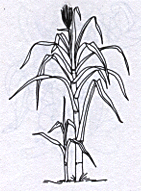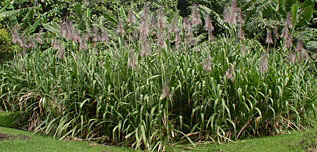Canoe Plants of Ancient Hawai`i Home - Intro - Contents - Bibliography - Links - Credits `Ape - `Awa -`Awapuhi -Hau -Ipu -Kalo -Kamani -Ki -Ko -Kou -Kukui -Mai`a Milo -Niu -Noni -`Ohe -`Ohi`a `Ai -`Olena -Olona -Pia -`Uala -Uhi -`Ulu -Wauke |
Canoe Plants of Ancient Hawai`i Home - Intro - Contents - Bibliography - Links - Credits `Ape - `Awa -`Awapuhi -Hau -Ipu -Kalo -Kamani -Ki -Ko -Kou -Kukui -Mai`a Milo -Niu -Noni -`Ohe -`Ohi`a `Ai -`Olena -Olona -Pia -`Uala -Uhi -`Ulu -Wauke |
 How paradoxical that such a graceful and sweet-tasting plant could be controversial. Simple were the days when ko, sugar cane, began its life here in Hawai`i, brought by Polynesian settlers in their canoes sailing forth. This plant travels well, plants easily, and is a pleasant addition to life. Only later came the days when other settlers began to grow sugar cane hybrids commercially. Modern-day hybrid sugar production causes concerns: to burn the fields or not, as their heat and the pollutants released all contribute to our personal health and the local and global environment...to eat the white sugar crystals that are processed from the original sap or not, as the overuse of this substance can become addictive and harmful to the immune system and good health of many people... yet, the glorious beauty of fields of green cane waving in the trade winds cannot be denied.
How paradoxical that such a graceful and sweet-tasting plant could be controversial. Simple were the days when ko, sugar cane, began its life here in Hawai`i, brought by Polynesian settlers in their canoes sailing forth. This plant travels well, plants easily, and is a pleasant addition to life. Only later came the days when other settlers began to grow sugar cane hybrids commercially. Modern-day hybrid sugar production causes concerns: to burn the fields or not, as their heat and the pollutants released all contribute to our personal health and the local and global environment...to eat the white sugar crystals that are processed from the original sap or not, as the overuse of this substance can become addictive and harmful to the immune system and good health of many people... yet, the glorious beauty of fields of green cane waving in the trade winds cannot be denied.| Pua ke ko, ne`e i ka he`e holua. When the sugarcane tassels, move to the sledding course. The tops of the sugarcane tassels were used as a slippery bedding for the sled to slide on. |
 In earlier times, the people of Hawai`i grew nearly 40 varieties of ko. Some of them were grown in clumps near their homes. These giant grasses were also planted on the embankments of the lo`i, taro ponds. Ko is a kinolau of Kane.
In earlier times, the people of Hawai`i grew nearly 40 varieties of ko. Some of them were grown in clumps near their homes. These giant grasses were also planted on the embankments of the lo`i, taro ponds. Ko is a kinolau of Kane.
A few varieties were used for medicines. Ko sweetens many medicinal concoctions, and the juice of pan-toasted sugar cane can be used as a tonic for babies.
One of the few varieties used medicinally is ko kea, white cane, a native cane with yellowish-green stem and a thin skin that can be easily removed or crushed. This juice is popular as an ingredient in herbal combinations. It helps to make bad-tasting medicine taste better. Honua`ula, red cane, and the dark-colored ko lahi are also considered to have particular healing properties.
Young ko shoots were used for lacerations and cuts. Along with other plants and salt, the shoots were wrapped in ti leaves and baked over charcoal. The juice was then squeezed and placed on a cut.
The juices of ko are used to sweeten haupia and kulolo desserts, made of coconut and taro, respectively. The leaves of ko were used for inside house thatching, or for outside if pili grass wasn't available. The flower stalks of sugar cane were used to fashion a dart, sometimes used during the Makahiki games for the Hawai`i New Year.
This plant makes an effective windbreak, and is also planted as a hedge or border. To propagate, plant sections of the mature upper portion of the stalk, using those pieces that have several nodes on them. Each node will create a new stalk. Dig a trench 6-8 inches deep and plant an 8-12 inch section sideways in the earth. Ko likes a lot of sunshine and also moisture, and whenever possible, a rich soil. Traditionally, sugar cane was planted in November-December.
For a treat, have a chew on a joint of your home-grown ko, the garden variety which has a thin rind and is easy to chew because of its soft pulp. Or, when hiking, carry a section of ko along, to slake your thirst.
![]()
| Canoe Plants of Ancient Hawai`i Home Intro - Contents - Bibliography - Links - Credits `Ape -`Awa -`Awapuhi -Hau -Ipu -Kalo -Kamani -Ki -Ko - Kou -Kukui -Mai`a |